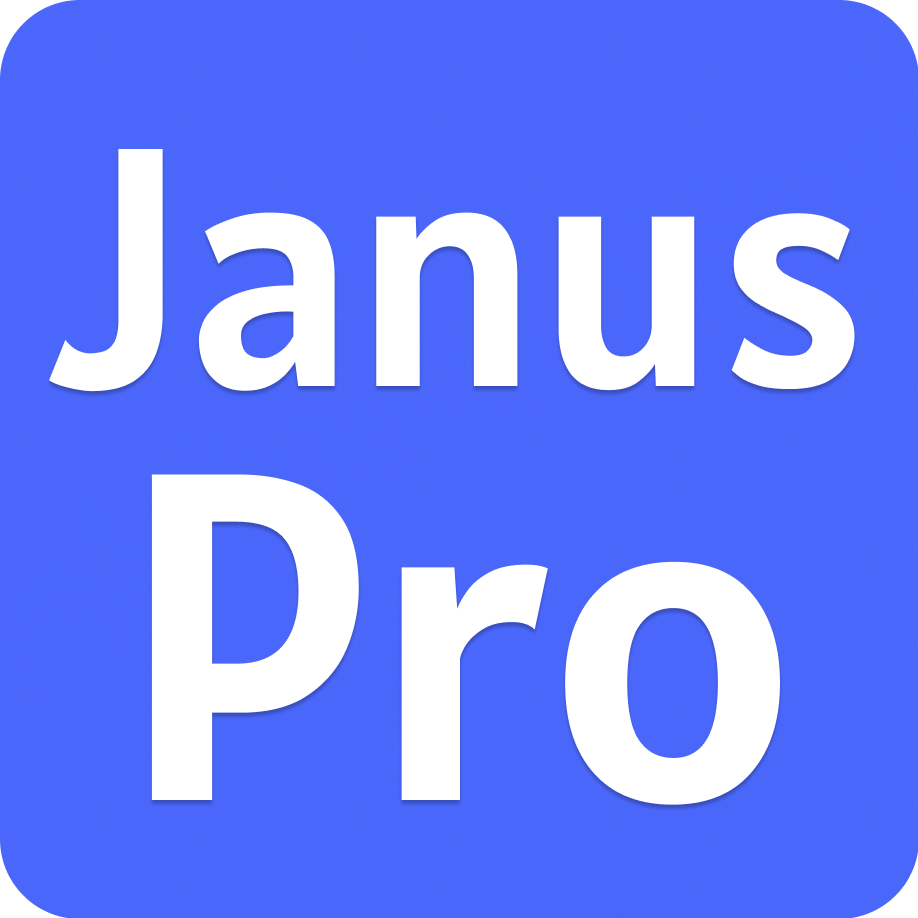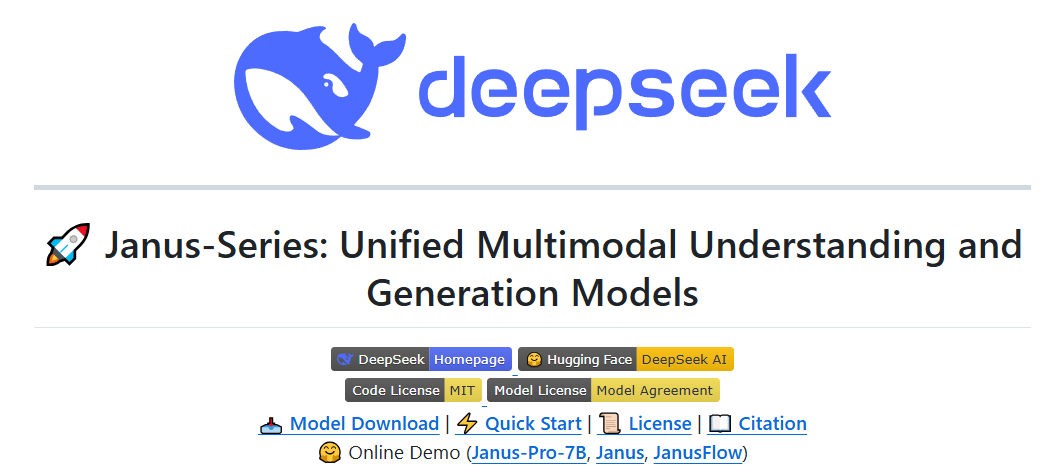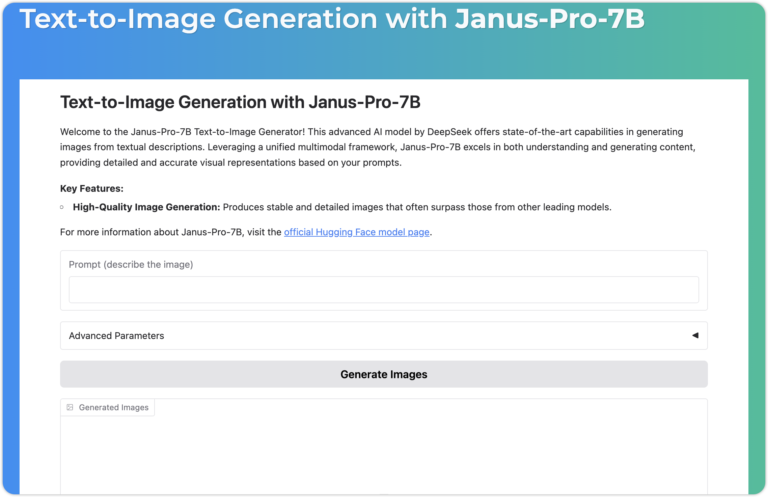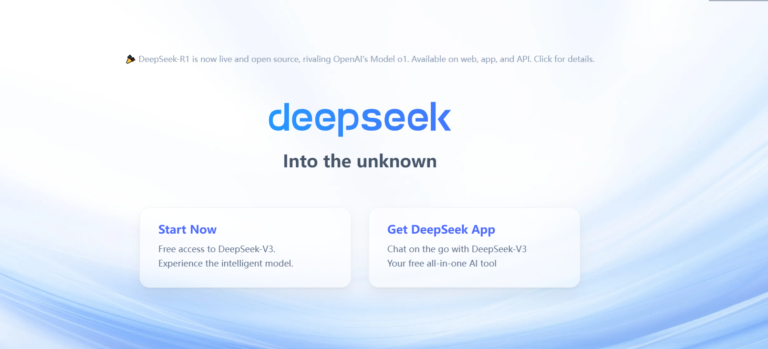deepseek’s low-cost, high-performance open source model has gone viral. Large numbers of new users have registered for the deepseek website, which has repeatedly caused the website to crash.
With the rapid development of artificial intelligence technology, large language models (LLMs) are changing every aspect of our work and lives.
But it has also seen many difficulties and challenges over the past period of time. And in this field, DeepSeek stands out with its innovative technology and outstanding performance.
We will take a deep dive into Janus Pro DeepSeek, the latest AI model and DeepSeek’s latest open source multimodal large model. Learn about its technical features, development history, and practical application value.
What is Janus Pro DeepSeek?

Janus Pro is an open-source multimodal AI model released by the DeepSeek team, mainly used for image understanding and image generation.
Core functions
- Multimodal understanding and generation: Janus Pro can process both text and images at the same time, both understanding the content of the image and generating images based on the text description.
- Open source and large-scale model: It is available in two parameter sizes, 1B and 7B, and is open source and commercially available
Development of Janus Pro DeepSeek
Establishment and development
- July 2023: DeepSeek is officially established, headquartered in Hangzhou, focusing on research and development in the field of general artificial intelligence (AGI).
- November 2, 2023: Release of the first open source code large model DeepSeek Coder, which supports code generation, debugging and data analysis tasks in multiple programming languages.
- November 29, 2023: DeepSeek LLM, a general-purpose large model with a parameter scale of 67 billion, is launched, including base and chat versions of 7B and 67B.
Technical breakthroughs and product iterations
- May 7, 2024: DeepSeek-V2, the second-generation open source hybrid expert (MoE) model, is released, with a total of 236 billion parameters and an inference cost reduced to only 1 RMB per million tokens.
- December 26, 2024: DeepSeek-V3 is released, with a total of 671 billion parameters. It adopts an innovative MoE architecture and FP8 mixed-precision training, and the training cost is only 5.576 million US dollars.
- January 20, 2025: DeepSeek-R1, a new generation of inference model, is released, with performance on par with OpenAI’s o1 official version, and open sourced.

On January 27, the janus pro multimodal model was released, and it was open-sourced immediately after release, so that more people can participate in the development process of large AI models and use and learn the latest AI technology with limited resources.
Janus Pro DeepSeek’s core technology

Visual coding decoupling
Janus Pro uses visual encoding decoupling technology to split the visual encoding path into independent processing paths, which are used for multimodal understanding and generation tasks respectively. This design effectively solves the problem of functional conflict between the visual encoder in the understanding and generation tasks in traditional multimodal models, and improves the flexibility and task adaptability of the model.
Unified Transformer architecture
Despite the decoupling of the visual encoding path, Janus Pro still uses a single Transformer architecture to handle multimodal tasks. This unified architecture simplifies model design while improving model scalability and the ability of models to work together across tasks.
Optimized training strategy
Janus Pro has made a number of optimizations to the training strategy, including
- Extending the training time of the ImageNet dataset to improve the model’s image understanding capabilities.
- Focusing on training text-to-image data, the model’s generative ability is optimized.
- Adjusting the proportion of training data ensures that the model performs more stably and efficiently in multimodal tasks.
Expanded training data
Janus Pro uses large-scale and diverse training data, including multimodal understanding data and visual generation data. The expansion of this data not only improves the model’s understanding ability, but also enhances its generative quality.
Innovative visual encoder
For multimodal understanding tasks, Janus Pro uses SigLIP-L as the visual encoder, which supports image inputs of up to 384×384 resolution. This high-resolution support allows the model to capture more image details, thereby improving the accuracy of visual understanding.
High-performance generative module
For image generation tasks, Janus Pro uses LlamaGen Tokenizer with a downsampling rate of 16 to generate more detailed images. This design makes the generated images more realistic and detailed.
Infrastructure innovations
Janus Pro is built on DeepSeek-LLM-1.5b and DeepSeek-LLM-7b models, which provide the model with powerful multi-modal processing capabilities, making it excel at multi-modal understanding and generation tasks.
Multi-modal understanding and generation capabilities
Janus Pro is capable of not only handling multimodal understanding tasks (such as visual question answering and image captioning), but also generating high-quality images from text descriptions. This ability makes it excel in multimodal scenarios.

Janus Pro DeepSeek performance
The Janus-Pro model of DeepSeek excels in multimodal understanding and generation tasks. The following is a detailed analysis of its performance:
Multimodal understanding performance
• MMBench benchmark: Janus-Pro-7B achieved a score of 79.2 in the MMBench benchmark for multimodal understanding, surpassing existing state-of-the-art unified multimodal models including Janus (69.4), TokenFlow (68.9), and MetaMorph (75.2).
• Visual question answering: Janus-Pro’s visual question answering accuracy surpasses GPT-4V, accurately identifying details in images and answering related questions.
Text-to-image command tracking
• GenEval benchmark test: Janus-Pro-7B achieved an overall accuracy of 80% in the GenEval test, significantly outperforming other models such as DALL-E 3 (67%) and Stable Diffusion 3 Medium (74%).
Complex Command Understanding: In the DPG-Bench test, Janus-Pro-7B scored an excellent 84.19 points and was able to accurately generate complex scenes such as “a snowy mountain with a blue lake at the top”.
Text-to-image generation performance
• Image quality and stability: Despite an output resolution of 384×384, the images generated by Janus-Pro-7B exhibit a high degree of realism and rich detail, especially when processing imaginative and creative scenes. It can accurately understand the semantic information in the prompt words and generate logically reasonable and coherent images.
• Generation speed: Janus-Pro supports 4K image generation on a single card, which is 2 times faster than Stable Diffusion 3.
Model architecture and training
• Decoupling of visual encoding: Janus-Pro uses an independent encoding method to convert the original input into features, which are then processed by a unified autoregressive Transformer to achieve the decoupling of visual encoding in multimodal understanding and generation tasks.
• Training data: Janus-Pro incorporates 72 million high-quality synthetic images into training to ensure a 1:1 ratio of real to synthetic data. It also adds about 90 million samples of multimodal understanding training data, significantly improving model performance.
Scalability and deployment
Model size: The Janus-Pro series provides models with 1B and 7B parameter sizes, which take into account both performance and computing costs and are suitable for more use cases.
Minimal deployment: Janus-Pro is released under the MIT license, supports commercial use, and provides two versions: 1.5B (requires 16GB VRAM) and 7B (requires 24GB VRAM), which can run on standard GPUs.
Practical application scenarios of Janus Pro DeepSeek
AI multimodal models, especially text-to-image models, have great potential for development in the commercial sector. After a long period of development, AI text-to-image models have already made great progress
In the most common scenario of advertising or poster design, designers or users can use Janus pro to input a text description to quickly generate high-quality posters. By iterating through poster prototypes, they can save design time and improve creative efficiency. This can greatly improve the efficiency of designers, who can spend time on more meaningful things
In addition to traditional poster design or advertising design, in the more popular game settings nowadays, the ai large model can also help designers to generate game scenes, characters and items in real time, reducing the cost and difficulty of development while improving the visual effects of the game. We believe that the ai large model can continue to unlock the potential and imagination of creators, and realize more interesting products
In addition to the field of design, in other fields of learning, education, and the professional vertical field of medicine, the multimodal model will also have a great development.
In the future, we may see the emergence of more very interesting applications that can greatly improve the efficiency and quality of our lives.
Meanwhile, Janus-Pro’s open source features (MIT license) and minimal deployment methods (supports running on standard GPUs) further reduce the barrier to entry, making it widely applicable to the above fields.
This allows more users to participate in development, so that more people can improve these functions and enhance the capabilities of the entire community.
How do I choose the right version of Janus Pro DeepSeek for me?
Janus-Pro is open-sourced in two versions: Janus-Pro-1B and Janus-Pro-7B. Which version you choose depends on your specific needs, computing resources and application scenarios. The following is a detailed comparison and recommendations:
Applicable scenarios
Janus-Pro-1B:
• Lightweight applications: suitable for use on mobile devices, in browsers or in resource-constrained environments. This allows more users to experience the latest Janus pro.
• Rapid prototyping: suitable for rapid development and testing of multimodal functions without requiring a lot of computing resources. This is very important for AI enthusiasts, who can quickly iterate and discover problems encountered in research without requiring a lot of computing resources.
Janus-Pro-7B:
• High-quality image generation: suitable for applications that require the generation of high-quality images of complex scenes, such as advertising design, game development, and artistic creation. This model is more suitable for more professional design scenarios, which require more powerful hardware capabilities and more powerful computing capabilities
• Complex instruction understanding: suitable for scenarios that need to process complex text instructions and generate accurate images, such as virtual reality (VR) and augmented reality (AR)
Deployment requirements
Janus-Pro-1B:
• Hardware requirements: suitable for running on resource-constrained devices, such as GPUs that require 16GB VRAM. If you only have an earlier graphics card, then this may be more suitable for you
• Application scenario: suitable for running in the browser or deploying on lightweight devices.
Janus-Pro-7B:
• Hardware requirements: requires higher computing resources, such as a GPU with 24GB VRAM. This will be more suitable for users with newer graphics cards
• Application scenario: suitable for running on standard GPUs and for scenarios that require high performance.
Summary
If your application scenario requires high image quality and complex instruction understanding, and you have sufficient computing resources, we recommend Janus-Pro-7B.
If you need lightweight deployment or have limited computing resources, we recommend Janus-Pro-1B.
Community support and resources
DeepSeek provides developers with a wealth of resources and support:
- The official documentation provides detailed API interface descriptions and technical guides, including model fine-tuning, deployment tutorials, and other content.
- The developer community provides forums and discussion groups to facilitate the exchange of experience among developers. Regular technical sharing sessions and hackathons are held.
- Technical support provides professional technical support services to solve problems encountered by users during use.




